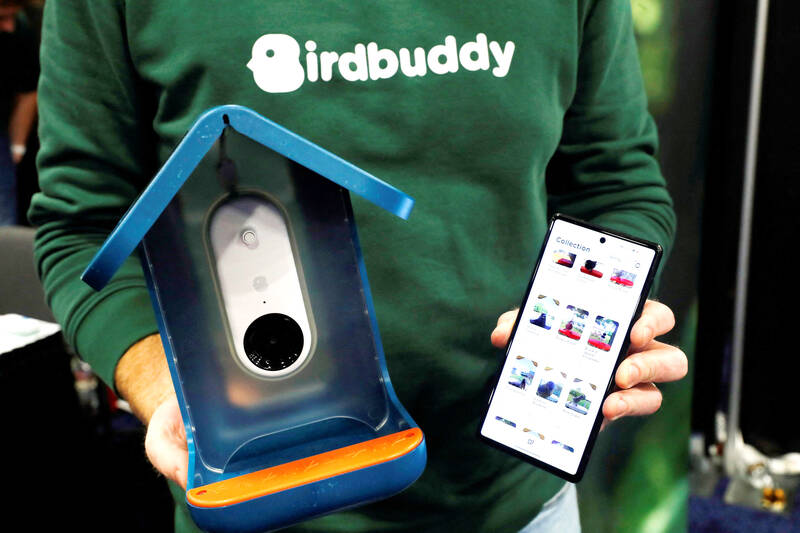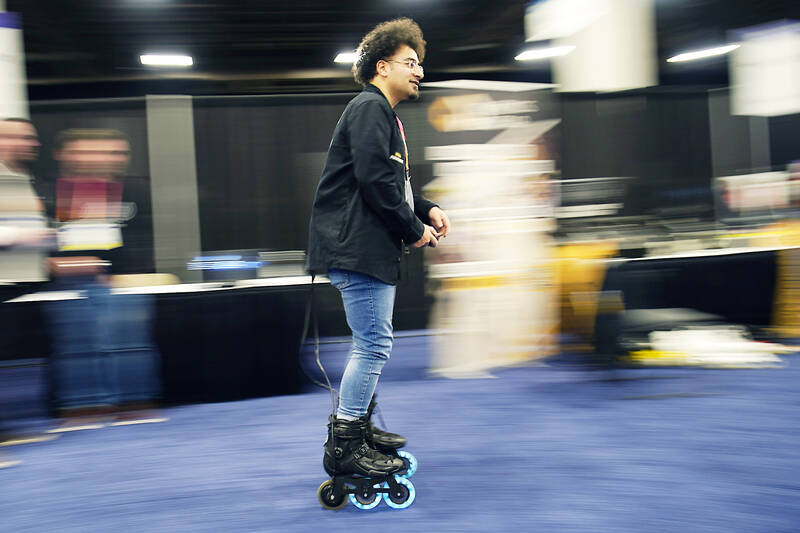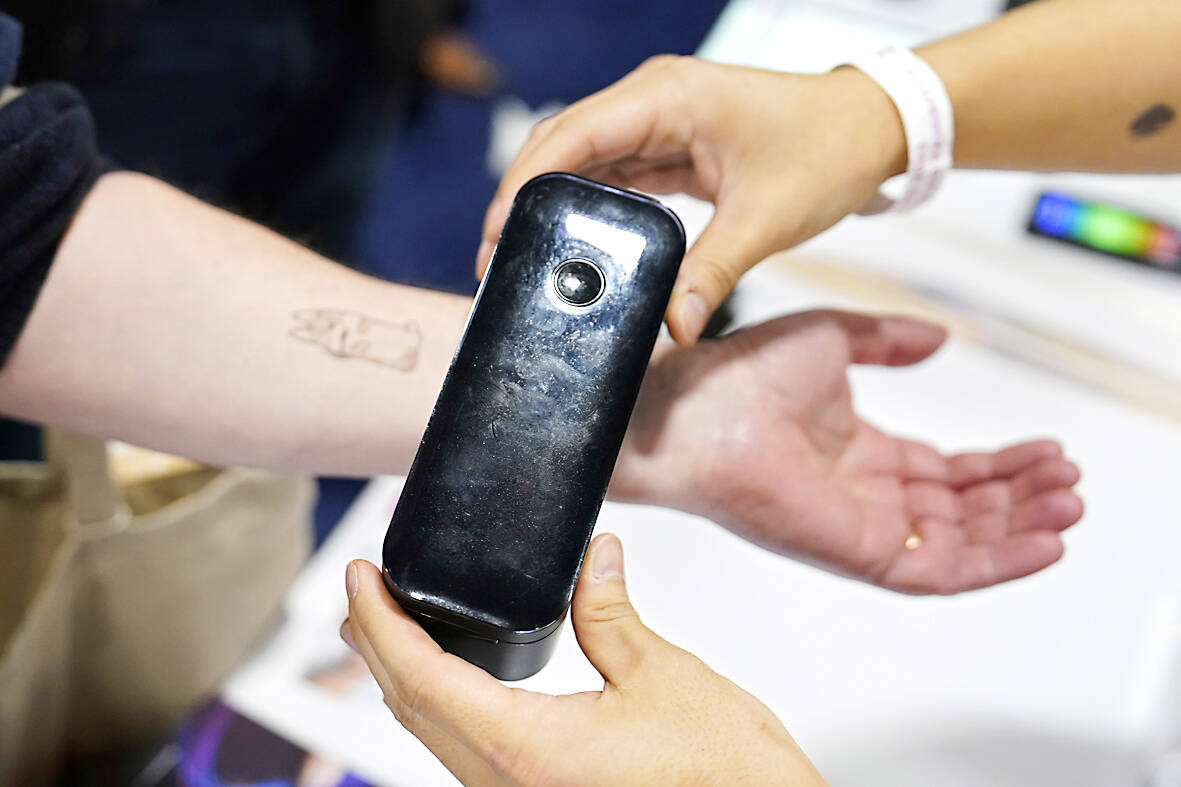Tech companies of all sizes are showing off their latest products at CES, formerly known as the Consumer Electronics show.
The show is getting back to normal after going completely virtual in 2021 and seeing a significant drop in last year’s attendance because of the pandemic.
Exhibitors range from big names including Sony and LG to tiny startups. You might see the next big thing or something that will never make it past the prototype stage.

Photo: Reuters
On Tuesday night, the show kicked off with media previews from just some of the 3,000 companies signed up to attend. CES officially opens Thursday.
Here are some highlights:
POKEMON, BUT MAKE IT BIRDS

Photo: AFP
Bird Buddy showed off a smart bird feeder that takes snapshots of feathered friends as they fly in to eat some treats. The startup says its AI technology can recognize more than 1,000 species of birds, allowing users to share through a mobile app what kind of birds they’re feeding.
“We try to kind of gamify the collection so it’s a really fun game that you can play — almost like a real life Pokemon Go with real animals and wildlife in your backyard,” said Kyle Buzzard, the company’s co-founder and chief hardware officer.
The product has already sparked some interest from consumers who want to show the world what birds are coming into their backyards.

Photo: AP
The company, which began as a Kickstarter project in 2020, says it started shipping its bird feeders in September and has already sold all 100,000 in its inventory. The price for the basic feeder is US$199.
ELECTRIC SKATES
Journalists had fun zipping around the exhibit hall on remote-controlled, electric inline skates from French startup AtmosGear.

Photo: AP
The battery lasts for 32 kilometers, said founder Mohamed Soliman, who hopes people will see them as a viable way to commute, like electric bikes or scooters.
“My goal is for everyone to go skating again because it’s so much fun, every time you see people skating you see them with a big smile,” Soliman said.
A waist bag holds the battery and cables connected to the skates. They also can be used as regular skates when they need to be charged or skaters simply want to travel under their own power.
The US$500 skates are available for pre-order. The company has taken orders for 150 pairs so far and is aiming for 200 orders to start production.
DIGITAL TEMPORARY TATTOOS
A handheld device displayed by South Korean company Prinker allows you to quickly and easily apply temporary tattoos.
The device uses cosmetic-grade ink with a library of thousands of designs or the option to make your own with the company’s app. After picking a tattoo, you just wave the device over wherever you want it applied. The tattoos are waterproof but wash off with soap.
The flagship model is US$279 and a smaller model is US$229. Ink cartridges good for 1,000 tattoos are US$119.
HELPING FIND YOUR WAY
Japan-based Loovic has created a device designed to solve the challenges of those who have difficulty navigating while they walk.
The device worn around the neck employs sounds and vibrations to guide users to destinations, enabling them to look at what’s around rather than focusing on a phone’s map app.
Loovic co-founder and CEO Toru Yamanaka said he was inspired to create the device for his son, who has a cognitive impairment making it difficult for him to navigate.
The prototype device is not yet available to the public.
A FITNESS TRACKER FOR YOUR DOG
If you wonder what your dog is doing while you’re not home, French startup Invoxia has a product for you. The company’s smart dog collar monitors your pet’s activity and sleep, sending the data to your phone.
The latest version unveiled at CES, which has a GPS tracker, includes more advanced heart health monitoring.
The collar is US$149 in the US while a monthly US$8.25 subscription to the app monitors the data and shares it with your veterinarian.
METAVERSE FOR KIDS
The creators of Roybi, an educational AI robot that helps children learn about STEM topics and new languages, are venturing into the metaverse.
The RoybiVerse is expected to offer stations where K-12 and higher education students can learn about a wide range of educational topics.
Users walking around the RoybiVerse will be able to visit an area where they’ll learn about dinosaurs or walk over to the virtual library where they can pick a book and read it.
The RoybiVerse, which is expected to launch in the summer, will be available in virtual reality headsets and on a website. No robot needed.

Seven hundred job applications. One interview. Marco Mascaro arrived in Taiwan last year with a PhD in engineering physics and years of experience at a European research center. He thought his Gold Card would guarantee him a foothold in Taiwan’s job market. “It’s marketed as if Taiwan really needs you,” the 33-year-old Italian says. “The reality is that companies here don’t really need us.” The Employment Gold Card was designed to fix Taiwan’s labor shortage by offering foreign professionals a combined resident visa and open work permit valid for three years. But for many, like Mascaro, the welcome mat ends at the door. A

Last week gave us the droll little comedy of People’s Republic of China’s (PRC) consul general in Osaka posting a threat on X in response to Japanese Prime Minister Sanae Takaichi saying to the Diet that a Chinese attack on Taiwan may be an “existential threat” to Japan. That would allow Japanese Self Defence Forces to respond militarily. The PRC representative then said that if a “filthy neck sticks itself in uninvited, we will cut it off without a moment’s hesitation. Are you prepared for that?” This was widely, and probably deliberately, construed as a threat to behead Takaichi, though it

Nov. 17 to Nov. 23 When Kanori Ino surveyed Taipei’s Indigenous settlements in 1896, he found a culture that was fading. Although there was still a “clear line of distinction” between the Ketagalan people and the neighboring Han settlers that had been arriving over the previous 200 years, the former had largely adopted the customs and language of the latter. “Fortunately, some elders still remember their past customs and language. But if we do not hurry and record them now, future researchers will have nothing left but to weep amid the ruins of Indigenous settlements,” he wrote in the Journal of

If China attacks, will Taiwanese be willing to fight? Analysts of certain types obsess over questions like this, especially military analysts and those with an ax to grind as to whether Taiwan is worth defending, or should be cut loose to appease Beijing. Fellow columnist Michael Turton in “Notes from Central Taiwan: Willing to fight for the homeland” (Nov. 6, page 12) provides a superb analysis of this topic, how it is used and manipulated to political ends and what the underlying data shows. The problem is that most analysis is centered around polling data, which as Turton observes, “many of these